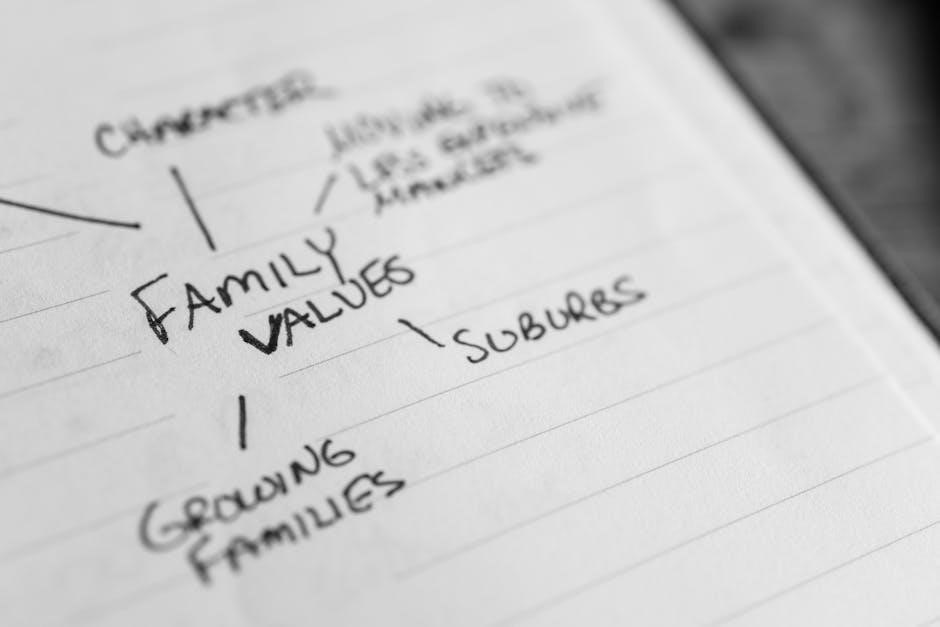Character development worksheets are tools helping writers craft well-rounded characters. They guide exploration of traits‚ backstory‚ and motivations‚ essential for adding depth and engagement to stories. Available as PDFs‚ they offer structured frameworks for creating memorable characters.
1.1 Definition and Purpose
A character development worksheet is a structured tool designed to help writers and storytellers create detailed‚ engaging characters; It typically includes prompts and sections for exploring traits‚ backgrounds‚ and motivations. The purpose of these worksheets is to guide the creation of well-rounded characters‚ ensuring they are relatable‚ memorable‚ and integral to the story. By using a worksheet‚ writers can delve into aspects like physical appearance‚ personality‚ and relationships‚ fostering depth and consistency. These tools are especially useful for authors seeking to craft characters that resonate with readers and drive the narrative forward. Available as PDFs‚ they offer a flexible framework for both novice and experienced writers to refine their character-building skills.
1.2 Benefits for Writers and Storytellers
Character development worksheets offer numerous benefits for writers and storytellers‚ enhancing the quality and depth of their characters. These tools help in creating complex‚ relatable characters by guiding the exploration of their strengths‚ weaknesses‚ and motivations. Worksheets ensure consistency in character portrayal‚ preventing contradictions and enriching the narrative. They also foster creativity‚ encouraging writers to think beyond surface traits and delve into unique voices and attitudes. By providing a structured format‚ worksheets save time and streamline the writing process. Additionally‚ they aid in developing character arcs‚ making stories more engaging and impactful. Overall‚ these resources are invaluable for crafting characters that resonate with audiences and drive compelling narratives.

Importance of Character Development in Writing
Character development enhances storytelling by creating depth and emotional connections. Well-crafted characters drive narratives‚ making stories memorable and engaging for readers.
2.1 Why Character Development Matters
Character development is the backbone of storytelling‚ bringing depth and emotional resonance to narratives. Well-crafted characters create connections with readers‚ making stories memorable and impactful. They drive plot progression and thematic exploration‚ ensuring engagement and immersion. Without compelling characters‚ stories often feel flat and uninspiring. Characters are the heart of any narrative‚ shaping reader emotions and reactions. Their growth and struggles captivate audiences‚ fostering empathy and understanding. Strong character development ensures that stories resonate long after the final page‚ making it a cornerstone of effective writing. By investing time in crafting relatable and complex characters‚ writers build a foundation for success.
2.2 Impact on Storytelling and Reader Engagement
Well-developed characters significantly enhance storytelling by driving plot dynamics and emotional resonance. Readers form connections with relatable and complex characters‚ fostering deeper engagement. A character’s growth and struggles create empathy‚ making stories memorable. Strong character development ensures narratives are immersive‚ capturing readers’ attention and investment. It also allows themes to resonate more powerfully‚ as characters embody and explore these ideas. Without compelling characters‚ stories risk feeling flat and disconnected. Effective character development ensures that readers remain invested‚ as they witness transformations and confront challenges alongside the characters. This emotional connection is vital for a story’s success‚ making character development a cornerstone of impactful storytelling.
2.3 Common Challenges in Building Compelling Characters
Creating compelling characters often presents challenges for writers. One common issue is balancing complexity with relatability‚ as overly complex characters may alienate readers‚ while overly generic ones lack depth. Another challenge is avoiding stereotypes or clichés‚ ensuring characters feel unique and authentic. Writers also struggle with maintaining consistency in a character’s voice and actions while allowing for growth and development. Additionally‚ making characters emotionally resonant without resorting to melodrama can be difficult. Some writers find it hard to integrate characters seamlessly into the plot‚ ensuring they feel essential to the story. Finally‚ crafting distinct and memorable character voices that don’t overlap with others in the narrative is a frequent hurdle. These challenges highlight the importance of tools like character development worksheets to guide the process.

Key Elements of a Character Development Worksheet
A character development worksheet typically includes sections for physical traits‚ personality‚ backstory‚ motivations‚ relationships‚ and goals. These elements help create well-rounded‚ believable characters for engaging stories.
3.1 Physical Description and Appearance
The physical description section in a character development worksheet helps writers visualize their characters. It includes details like age‚ height‚ weight‚ hair color‚ and facial features. This section also explores unique traits‚ such as scars‚ tattoos‚ or distinctive clothing. By fleshing out a character’s appearance‚ writers can create a vivid mental image‚ which aids in consistent storytelling. Some worksheets also prompt writers to consider how a character’s appearance reflects their personality or backstory. For example‚ a rugged exterior might hint at a challenging past; This attention to detail ensures characters feel authentic and memorable‚ enhancing reader engagement and immersion in the story. Effective physical descriptions can also influence character interactions and plot dynamics‚ making this section a foundational element of the worksheet.
3.2 Personality Traits and Psychological Depth
Personality traits and psychological depth are crucial for creating multi-dimensional characters. Worksheets often include prompts to explore strengths‚ weaknesses‚ and motivations‚ helping writers craft relatable and believable individuals. This section delves into a character’s emotional landscape‚ including fears‚ desires‚ and values. By defining core traits‚ writers can predict how characters will react in various situations‚ ensuring consistency and authenticity. Psychological depth also involves exploring a character’s inner conflicts and growth‚ adding layers to their development. Some worksheets incorporate questions about speech patterns‚ decision-making styles‚ and relationships‚ further enriching the character’s identity. This focus on inner workings ensures characters feel real and engaging‚ making them central to the story’s emotional resonance and reader connection. The goal is to create characters that evolve meaningfully‚ leaving a lasting impact on the narrative.
3.3 Background‚ History‚ and Motivations
Exploring a character’s background‚ history‚ and motivations is essential for creating depth and purpose. Worksheets often include prompts to delve into a character’s upbringing‚ family dynamics‚ and significant life events. Understanding their past helps explain their present actions and decisions. Motivations‚ whether driven by desires‚ fears‚ or goals‚ shape their behavior and interactions. This section encourages writers to uncover how past experiences influence current attitudes and relationships. By defining a character’s history‚ writers can craft meaningful arcs and ensure their actions align with their core values. Worksheets may also ask about cultural influences‚ past traumas‚ or pivotal moments that define who they are. This layer of development ensures characters feel authentic and their motivations are clear‚ making them more relatable and engaging for readers. It’s about building a foundation that explains why they think‚ feel‚ and act the way they do.
3.4 Relationships and Interactions with Other Characters
Examining how characters interact with others is vital for building a dynamic story. Worksheets often include sections to map relationships‚ alliances‚ and conflicts. This helps writers understand how each character influences others and vice versa. By detailing interactions‚ writers can create realistic dynamics‚ such as friendships‚ rivalries‚ or mentorships. These relationships add depth to the narrative and reveal character traits through their behavior in different social contexts. Worksheets may also explore how interactions evolve over time‚ contributing to character growth. Understanding these connections ensures characters feel interconnected and their roles within the story are clear. This section helps writers craft realistic and engaging social dynamics‚ making the story more immersive for readers. It’s about showing how relationships shape who characters are and how they develop throughout the story. This adds layers to both individual characters and the overall plot.
3.5 Goals‚ Conflicts‚ and Character Arcs
Understanding a character’s goals‚ conflicts‚ and arcs is essential for meaningful development. Worksheets often include sections to outline what motivates a character‚ the obstacles they face‚ and how they change over time. Goals provide direction‚ driving the character’s actions and decisions. Conflicts‚ whether internal or external‚ create tension and propel the story forward. Character arcs reveal growth‚ showing how experiences transform the character. Worksheets help writers map these elements‚ ensuring consistency and depth. By exploring these aspects‚ writers can craft realistic and engaging character journeys. This section is crucial for creating relatable and dynamic characters who evolve throughout the story‚ making the narrative more compelling for readers. It ties together motivation‚ challenge‚ and transformation‚ forming a complete character portrait.

Types of Character Development Worksheets
Character development worksheets vary‚ offering basic‚ advanced‚ and specialized options. They cater to different writing needs‚ from foundational traits to complex‚ genre-specific character building‚ ensuring versatility for all writers.
4.1 Basic Worksheets for Beginners

Basic character development worksheets are designed for new writers‚ offering simple prompts and structured sections. They typically cover fundamental aspects like name‚ age‚ appearance‚ and personality traits. These tools help beginners establish clear character profiles without overwhelming complexity. Many free PDFs are available online‚ providing step-by-step guides to build foundational characters. They often include questions about strengths‚ weaknesses‚ and motivations‚ making it easy for novices to start crafting relatable characters. These worksheets are ideal for those looking to understand the basics of character creation before moving on to more advanced techniques. By focusing on essential elements‚ they provide a solid starting point for developing well-rounded characters in any story.
4.2 Advanced Worksheets for Detailed Character Building
Advanced character development worksheets are tailored for experienced writers seeking in-depth character analysis. They offer detailed sections for exploring psychological depth‚ complex relationships‚ and nuanced motivations. These worksheets often include prompts for character arcs‚ internal conflicts‚ and subtle traits‚ helping to create multi-dimensional personalities. Some advanced tools are fillable PDFs‚ allowing writers to organize their thoughts digitally. They may also incorporate unique exercises‚ such as dialogue analysis or scenario-based development‚ to refine character voices. Advanced worksheets are ideal for those aiming to craft relatable yet intricate characters. By diving deeper into character psychology and backstory‚ these resources enable writers to build characters that resonate powerfully with readers. They are particularly useful for genres requiring rich character dynamics‚ such as literary fiction or drama.
4.3 Specialized Worksheets for Specific Genres
Specialized character development worksheets cater to specific genres‚ offering tailored prompts and exercises. For fantasy‚ they might include sections for magical abilities or world-specific traits‚ while romance worksheets focus on emotional journeys and relationships. Sci-fi worksheets often explore futuristic elements‚ alien species‚ or advanced technologies. These tools help writers craft characters that align with genre expectations while maintaining uniqueness. For example‚ historical fiction worksheets might emphasize period-appropriate language and cultural context. Mystery and thriller worksheets could delve into moral dilemmas or secret identities. By addressing genre-specific needs‚ these worksheets ensure characters feel authentic to their fictional worlds. They provide targeted guidance‚ enabling writers to create compelling‚ genre-appropriate characters that captivate readers. This specialization makes them invaluable for writers aiming to excel in particular storytelling niches.

How to Use a Character Development Worksheet
Start by filling in basic details‚ then explore deeper traits like motivations and conflicts. Review and refine to ensure consistency and depth in your character’s development journey.
5.1 Step-by-Step Guide to Filling Out the Worksheet
Begin with basic details like name‚ age‚ and physical appearance. Next‚ explore personality traits‚ strengths‚ and weaknesses. Delve into backstory‚ motivations‚ and relationships. Define goals‚ conflicts‚ and character arcs. Use prompts to add depth and nuance. Review and refine to ensure consistency and believability. Utilize fillable PDFs for ease and organization. Refer to examples or guides‚ like those inspired by Pixar‚ for inspiration. Regularly revisit and update the worksheet as your character evolves. This structured approach helps create well-rounded‚ engaging characters essential for compelling storytelling.
5.2 Tips for Getting the Most Out of the Worksheet
To maximize the benefits of a character development worksheet‚ start by thoroughly exploring each section‚ beginning with basic traits and progressing to deeper nuances. Use fillable PDFs for organization and ease of revisiting. Save multiple drafts to track character evolution. Encourage creativity by answering prompts with vivid descriptions. Consider moral dilemmas or challenges to add depth. Regularly revisit the worksheet to ensure consistency and growth. Combine it with writing exercises to bring characters to life. Use visual aids like vision boards for inspiration. Finally‚ share your worksheet with peers for feedback‚ gaining fresh perspectives to refine your character. These strategies ensure your worksheet becomes a powerful tool for crafting compelling‚ memorable characters.

5.3 Case Studies and Examples of Successful Use
Many writers have successfully used character development worksheets to enhance their storytelling. For instance‚ one novelist credited a Pixar-inspired worksheet with helping her create a protagonist whose depth resonated deeply with readers. Another writer shared how filling out a detailed worksheet transformed a flat character into a dynamic‚ relatable figure. A group of students used a worksheet to develop characters for a school play‚ resulting in compelling performances. These examples highlight how structured tools can foster creativity and consistency. By applying the worksheet’s prompts‚ writers can craft characters that feel authentic and engaging‚ ultimately enriching their stories. Such success stories demonstrate the practical value of these resources in the writing process.

Advanced Techniques for Character Development
Advanced techniques involve layering complexity‚ exploring nuances‚ and adding depth. They encourage writers to craft multi-dimensional characters with rich inner lives‚ inspired by resources like Pixar and Khan Academy.
6.1 Creating Complex and Relatable Characters
Creating complex and relatable characters involves delving into their psychological depth‚ motivations‚ and emotional journeys. Worksheets guide writers to explore traits‚ flaws‚ and strengths‚ ensuring characters resonate with readers. They help craft multi-dimensional personalities‚ making stories more engaging. By focusing on unique voices and realistic interactions‚ writers can develop characters that feel authentic and memorable. These techniques‚ often inspired by resources like Pixar and Khan Academy‚ emphasize the importance of depth and nuance in character building. A well-structured worksheet can transform flat characters into compelling‚ lifelike individuals‚ essential for captivating storytelling.
6.2 Incorporating Subtle Traits and Nuances
Incorporating subtle traits and nuances into character development enhances authenticity and depth. Worksheets often include prompts for unique voices‚ word choices‚ and attitude‚ helping writers refine their characters’ tone. For example‚ listing catchphrases or favorite memories adds layers to a character’s personality. Advanced worksheets encourage exploring subtle psychological aspects‚ such as internal conflicts or unspoken fears‚ making characters more relatable. These tools also guide writers to balance overt traits with understated qualities‚ ensuring characters feel real and multi-dimensional. By focusing on these details‚ writers can craft characters that resonate deeply with readers‚ making their stories more immersive and engaging. This level of nuance is crucial for creating characters that stand out and leave a lasting impression.
6.3 Balancing Character Growth and Consistency
Balancing character growth and consistency is crucial for believable development. Worksheets help track progression by documenting strengths‚ weaknesses‚ and motivations‚ ensuring actions align with their core traits. They also guide exploration of how characters evolve without losing their essence; Advanced tools include sections for mapping arcs and resolving conflicts‚ maintaining coherence. Worksheets prevent inconsistencies by providing a clear record of traits and backstory. This balance ensures characters grow naturally while remaining true to their identity‚ enhancing reader engagement and story credibility. By using such resources‚ writers can craft authentic‚ dynamic characters that evolve seamlessly throughout the narrative.

Tools and Resources for Effective Character Development
Discover free PDF worksheets‚ Pixar-inspired guides‚ and fillable resources to craft compelling characters. These tools offer structured prompts and exercises to deepen character traits‚ backstory‚ and motivations effectively.

7.1 Free PDF Worksheets Available Online
Free PDF worksheets are widely available online‚ offering writers a convenient way to develop characters. These resources often include detailed prompts and exercises to explore strengths‚ weaknesses‚ and motivations. Many worksheets are designed to be printable‚ making them easy to use during brainstorming sessions. Some popular options include 160 character development questions‚ which provide a comprehensive approach to understanding fictional characters. These tools are ideal for both beginners and experienced writers‚ offering a structured format to enhance creativity and depth. Additionally‚ worksheets inspired by renowned resources like Pixar’s character development guides are available‚ ensuring high-quality and effective character-building exercises. These free PDFs are a valuable starting point for anyone looking to craft compelling and memorable characters.
7.2 Paid Resources and Workbooks
Paid character development resources and workbooks offer advanced tools for writers seeking deeper insights. These detailed guides provide comprehensive exercises‚ examples‚ and expert tips to craft complex characters. Many paid workbooks include interactive elements‚ such as fillable PDFs and step-by-step tutorials‚ designed to enhance creativity and precision. They often cater to both fiction and non-fiction writers‚ offering tailored approaches for specific genres. Paid resources may also include video tutorials‚ webinars‚ or community access‚ making them a valuable investment for serious writers. While free worksheets are a great starting point‚ paid resources offer a more structured and immersive experience‚ helping writers refine their skills and create memorable characters.
7.3 Recommended Worksheets Inspired by Pixar and Khan Academy
Worksheets inspired by Pixar and Khan Academy offer unique approaches to character development‚ blending storytelling expertise with educational rigor. These resources often include fillable PDFs designed to help writers envision characters as singular‚ cohesive entities. They emphasize creating relatable and unique characters by exploring their physical descriptions‚ personalities‚ backgrounds‚ and relationships. One such worksheet‚ part of a series inspired by Pixar’s course on Khan Academy‚ provides prompts to inspire character voices‚ focusing on word choices‚ attitudes‚ and tones. These tools are particularly valuable for writers seeking to craft compelling characters with depth and nuance‚ making them indispensable for both novices and experienced storytellers aiming to elevate their character development skills.
Character development worksheets are invaluable tools for crafting compelling characters. Utilize free PDF resources‚ like those inspired by Pixar and Khan Academy‚ to enhance your storytelling and create memorable characters.
8.1 Recap of the Importance of Character Development
Character development is the backbone of engaging storytelling‚ ensuring characters are memorable and relatable. It drives plot progression and enhances reader emotional investment. Worksheets‚ like free PDFs inspired by Pixar and Khan Academy‚ provide structured frameworks to explore traits‚ backstories‚ and motivations‚ helping writers create complex‚ believable characters. These tools also address common challenges‚ such as adding depth and consistency‚ fostering growth throughout the story. By investing time in character development‚ writers can craft narratives that resonate deeply with audiences‚ making their stories unforgettable. The resources available‚ from basic to advanced worksheets‚ offer tailored approaches for writers at all levels‚ ensuring continuous improvement in their craft.
8.2 Encouragement to Start Using Worksheets
Starting with character development worksheets is a simple yet powerful step toward enhancing your writing. These tools are designed to be user-friendly‚ offering a clear structure to guide you in creating vivid‚ believable characters. Whether you’re a beginner or an experienced writer‚ worksheets provide a fun and insightful way to dive deeper into your characters’ traits‚ backgrounds‚ and motivations. With free‚ downloadable PDFs available‚ such as those inspired by Pixar and Khan Academy‚ there’s no barrier to getting started. Embrace these resources to bring your characters to life and watch your stories become more engaging and impactful. The effort you invest in character development will shine through in your writing‚ making it a worthwhile endeavor for any storyteller.
8.3 Final Tips for Continuous Improvement
Continuous improvement in character development requires consistent practice and reflection. Regularly revisit and refine your worksheets to ensure your characters grow and evolve. Experiment with different worksheet types‚ such as those inspired by Pixar or Khan Academy‚ to uncover new layers in your characters. Reflect on their arcs and motivations to deepen their emotional resonance. Seek feedback from peers or writing groups to gain fresh perspectives. Finally‚ stay observant of real-life interactions to inspire authentic traits and behaviors. By integrating these strategies‚ you’ll continually enhance your ability to craft compelling‚ memorable characters that captivate readers and drive your stories forward.